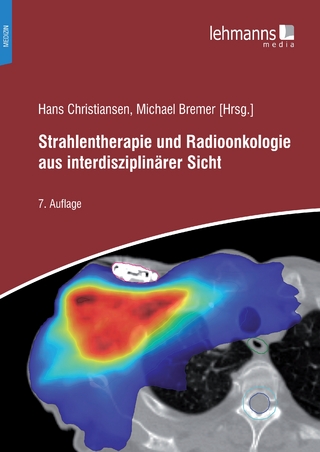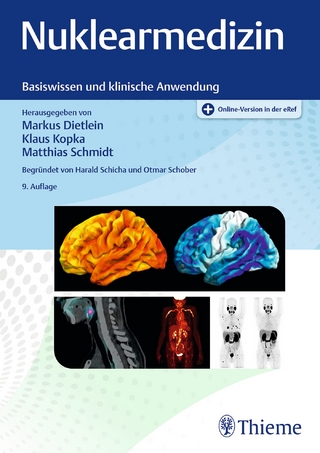
Applied Physics for Radiation Oncology
Medical Physics Publishing Corporation (Verlag)
978-1-930524-40-8 (ISBN)
The updated, second edition of the textbook Applied Physics for Radiation Oncology, originally published in 1996 is intended for both radiation therapists and students of radiation therapy. Chapters cover treatment planning, photon and electron dosimetry, brachytherapy, methods of dose calculation, isodose curves, beam-modifying devices, patient and beam geometry, radiation protection, and clinical use and operation of linear accelerators. The authors unify the principles of radiation therapy physics with the real world of clinical practice. A must for radiation therapists.
Applied Physics for Radiation Oncology
Acknowledgements
Matter and Energy
Matter
Force
Energy
Radiation and Its Properties
The Structure of an Atom
Subatomic Particles
Ionizing Radiation
Linear Energy Transfer
Electromagnetic Radiation
Wave-Particle Duality
Wavelength and Frequency
The Production of X-Rays
The Discovery of X-Rays
Collision Interactions
Characteristic Radiation
Radiative Interactions (Bremsstrahlung)
Filters Used in Conventional X-Ray Therapy
Beam Direction as a Function of Incoming Electron Energy
Beam Direction Dependency on X-Ray Target Design
Radiation Quality
X-Ray Intensity
Beam Divergence
Beam Attenuation
Attenuation Coefficients
5. X-Ray and ?-Ray Interactions with Matter
Attenuation Coefficients
Coherent Scatter
Photoelectric Effect
Compton Effect
Pair Production
Pair Annihilation
Photonuclear Interaction
Energy Absorption
Principles of Radiation Detectors
Measurement of Radiation
Gas Ionization Detectors
How to Use a Survey Meter
Scintillation Detectors
Neutron Dosimeters
Thermoluminescent Dosimeters
Diode Detectors
MOSFET Detectors
Determining Radiation Intensity
The Importance of Standardized Radiation Measurement
The Roentgen as a Unit of Exposure
Kerma
"Conventional" X-Ray Machine Calibrations
Radiation Absorbed Dose
The fmedium Factor
Cavity Theory
Dose Equivalent
Why Use Higher Energy Beams?
Disadvantages of Low-Energy Machines
Penumbra Size
Inability to Use Isocentric Techniques
Advantages of Megavoltage over Orthovoltage Beams
Skin Sparing
Electron Equilibrium
Disadvantages of Megavoltage
Linear Accelerators
Accelerator Guides
Waveguides
Power Sources
Bending Magnets
The Raw Electron Beam
X-Ray Beam Production
X-Ray Beam Flattening Filters
Photon Beam Collimation
Electron Beam Production
Electron Scattering Foils
Electron Beam Collimation
Monitor Chambers for Photon and Electron Beams
Helical Technology
The Linear Accelerator Console: The Operator Interface
Quality Assurance
Other High-Energy Machines
Cobalt-60 Machines (Radionuclide Teletherapy)
Timer Error
Penumbra
Quality Assurance of Cobalt-60 Machines
Cyclotrons
Heavy Particle Therapy
The Geometry of Photon Beams
Similar Triangles
Magnification
Abutting Fields
Non-Midplane Structures
Perpendiculars
Planes
Simple Beam Arrangements
Isocentricity
Conventional Beam Blocking
Multileaf Collimation
IMRT
Photon Beam Dosimetry
Dose and Distance Terms
Dose Fractionation
Quantities Used in Treatment Calculations
Backscatter Factor
Output Factor
Equivalent Square Fields
Equipment Attenuation Factors
Patient Attenuation Factors
Depth Dose
Tissue-Air Ratio (TAR)
Tissue-Maximum Ratio (TMR)
Isodose Curves
Dose Profiles
Moving Field Calculations
Computers
Electron Beam Dosimetry
Electron Beam Interactions
Electron Beam Characteristics
Electron Beam Profiles
Gaps and Abutting Fields
Electron Dose Measurements
Treatment Calculations
Irregularly Shaped Fields
Tissue Inhomogeneities
Inverse Square Law
Treatment Planning
Tumor Targeting Vocabulary
Aims of Treatment Planning
What Treatment Planning Includes
Patient Alignment Devices
Patient Positioning Aids
Body Contours
Isodose Distributions
Oblique Incidence Corrections to Isodose Distributions
Isodose Summations
Treatment Techniques
Stationary or Fixed Beam Treatment
Moving Fields Treatment
Tissue Inhomogeneities
Tissue Compensation
Wedge Filters
Standard Treatment Calculation
Beam On Time Calculations (Timer Settings)
Monitor Unit Calculations
Clinical Applications in Treatment Planning
More Field Nomenclature
Mixed Beams
Tangents
Field Weighting
Normalization
Non-Coplanar Beams
Three-Dimensional Treatment Planning
Conformal Methods
IMRT
IGRT
Gated Radiation Therapy
Brachytherapy
Introduction
Radium
Radium Substitutes
Radioactive Sources
Applicators
Afterloading
Single Plane, Double Plane, and Volume Implants
Permanent Implants
Implant Dosimetry
Remote High-Intensity Afterloading
Specific Implant Techniques
Radiation Safety with Implants
Radiation Safety
Recommendations and Regulations
Measurement of Occupational Radiation Dose
Radiation Risk
Maximum Permissible Dose Equivalents
Personnel Monitoring
Time, Distance, and Shielding
Radioactive Materials
Radiation-Producing Machines
Signs
Appendix 1: Signs and Symbols
Appendix 3: Glossary
Appendix 5: Dosimetry Tables
Appendix 7: The Elements
Periodic Table
Index
| Verlagsort | Madison, WI |
|---|---|
| Sprache | englisch |
| Maße | 178 x 254 mm |
| Themenwelt | Medizin / Pharmazie ► Medizinische Fachgebiete ► Onkologie |
| Medizinische Fachgebiete ► Radiologie / Bildgebende Verfahren ► Nuklearmedizin | |
| Medizinische Fachgebiete ► Radiologie / Bildgebende Verfahren ► Radiologie | |
| Naturwissenschaften ► Physik / Astronomie ► Angewandte Physik | |
| ISBN-10 | 1-930524-40-4 / 1930524404 |
| ISBN-13 | 978-1-930524-40-8 / 9781930524408 |
| Zustand | Neuware |
| Haben Sie eine Frage zum Produkt? |
aus dem Bereich


